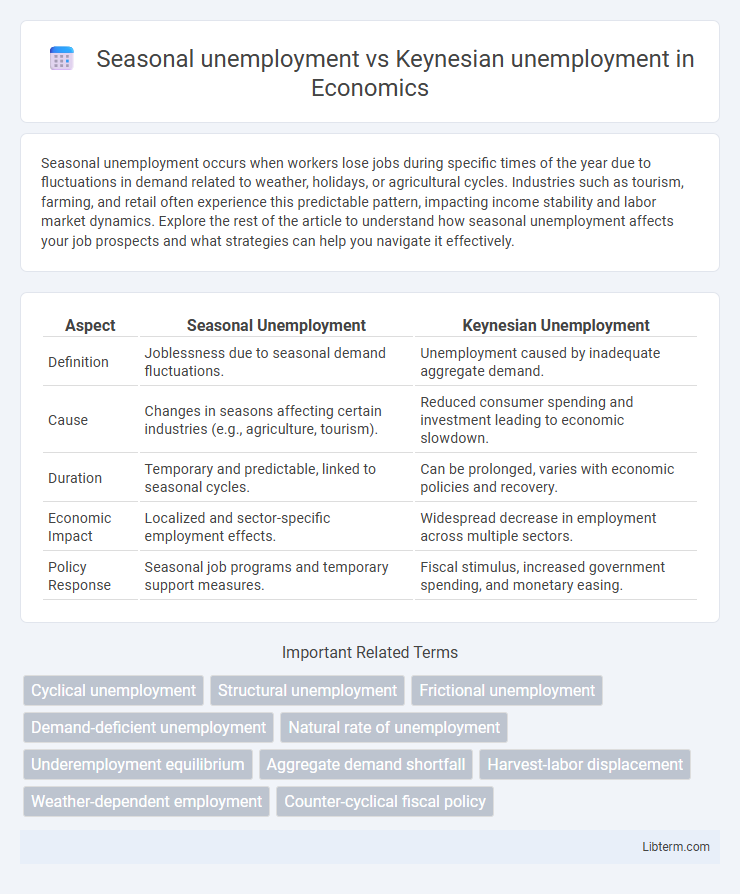Seasonal unemployment occurs when workers lose jobs during specific times of the year due to fluctuations in demand related to weather, holidays, or agricultural cycles. Industries such as tourism, farming, and retail often experience this predictable pattern, impacting income stability and labor market dynamics. Explore the rest of the article to understand how seasonal unemployment affects your job prospects and what strategies can help you navigate it effectively.
Table of Comparison
| Aspect | Seasonal Unemployment | Keynesian Unemployment |
|---|---|---|
| Definition | Joblessness due to seasonal demand fluctuations. | Unemployment caused by inadequate aggregate demand. |
| Cause | Changes in seasons affecting certain industries (e.g., agriculture, tourism). | Reduced consumer spending and investment leading to economic slowdown. |
| Duration | Temporary and predictable, linked to seasonal cycles. | Can be prolonged, varies with economic policies and recovery. |
| Economic Impact | Localized and sector-specific employment effects. | Widespread decrease in employment across multiple sectors. |
| Policy Response | Seasonal job programs and temporary support measures. | Fiscal stimulus, increased government spending, and monetary easing. |
Introduction to Unemployment Types
Seasonal unemployment occurs when workers are temporarily out of jobs due to periodic fluctuations in demand tied to seasons, affecting industries like agriculture, tourism, and retail. Keynesian unemployment arises from insufficient aggregate demand in the economy, leading to prolonged periods of joblessness despite available labor. Understanding these unemployment types helps economists design targeted fiscal policies to stabilize the labor market and promote economic growth.
Defining Seasonal Unemployment
Seasonal unemployment occurs when workers are temporarily out of jobs due to predictable changes in demand or production cycles within specific industries, such as agriculture, tourism, and retail during holidays. This type of unemployment is characterized by fluctuations tied to seasons or periods of the year, leading to workforce reductions that are anticipated and recurrent. Unlike Keynesian unemployment, which results from insufficient aggregate demand causing widespread joblessness, seasonal unemployment reflects systematic timing variations in labor needs rather than economic downturns.
Understanding Keynesian Unemployment
Keynesian unemployment occurs when aggregate demand in the economy is insufficient to support full employment, leading to prolonged periods of joblessness even when seasonal factors are not at play. Unlike seasonal unemployment, which is temporary and predictable due to fluctuations in demand for labor during specific times of the year, Keynesian unemployment reflects a broader economic downturn and inadequate spending. This type of unemployment highlights the importance of government intervention through fiscal and monetary policies to stimulate demand and restore economic stability.
Key Differences Between Seasonal and Keynesian Unemployment
Seasonal unemployment occurs due to regular fluctuations in demand tied to specific seasons, such as agriculture or tourism, leading to predictable job losses during off-peak times. Keynesian unemployment arises from insufficient aggregate demand in the economy, causing widespread job shortages unrelated to seasonal patterns. While seasonal unemployment reflects temporary and cyclical job gaps, Keynesian unemployment indicates deeper economic downturns requiring fiscal or monetary intervention.
Causes of Seasonal Unemployment
Seasonal unemployment arises from predictable fluctuations in labor demand tied to seasonal patterns in industries like agriculture, tourism, and retail, where work availability varies throughout the year. This form of unemployment occurs when workers are temporarily laid off during off-peak seasons due to reduced demand for seasonal goods and services. Unlike Keynesian unemployment, which stems from insufficient aggregate demand in the economy, seasonal unemployment is driven primarily by external, calendar-dependent factors affecting specific labor markets.
Causes of Keynesian Unemployment
Keynesian unemployment occurs primarily due to insufficient aggregate demand in the economy, leading to reduced production and layoffs despite available labor. This type of unemployment often arises during economic downturns when consumers and businesses cut back on spending, causing a negative cycle of decreased income and job losses. Unlike seasonal unemployment, which results from predictable, regular fluctuations in labor demand across different times of the year, Keynesian unemployment is driven by overall economic slack and lack of effective demand.
Economic Impact of Seasonal Unemployment
Seasonal unemployment arises from predictable fluctuations in demand related to specific times of the year, significantly impacting industries such as agriculture, tourism, and retail by causing temporary layoffs and income instability for workers. This type of unemployment leads to reduced consumer spending and lower aggregate demand during off-peak seasons, affecting local economies dependent on seasonal industries. In contrast, Keynesian unemployment stems from insufficient aggregate demand across the broader economy, necessitating fiscal stimulus to boost spending and employment levels.
Economic Impact of Keynesian Unemployment
Keynesian unemployment arises during aggregate demand deficiencies, causing prolonged economic downturns and reduced GDP growth. This form of unemployment leads to lower consumer spending, decreased business investment, and higher government expenditure on social welfare programs. Addressing Keynesian unemployment requires fiscal stimulus policies to boost demand and restore full employment levels.
Policy Responses to Seasonal vs Keynesian Unemployment
Policy responses to seasonal unemployment often involve short-term measures such as temporary job programs, enhanced unemployment benefits during off-peak seasons, and skills training aimed at improving worker flexibility. Keynesian unemployment, linked to insufficient aggregate demand, requires fiscal and monetary policies like government spending increases, tax cuts, and interest rate reductions to stimulate economic activity and boost employment. Targeted interventions are essential to address the structural causes of seasonal unemployment, whereas Keynesian unemployment demands demand-side macroeconomic strategies to restore full employment.
Conclusion: Addressing Unemployment Challenges
Seasonal unemployment occurs due to predictable fluctuations in labor demand linked to seasons, while Keynesian unemployment arises from insufficient aggregate demand during economic downturns. Addressing unemployment challenges requires targeted policies such as job training and diversification for seasonal workers, alongside fiscal stimulus to boost overall economic activity in Keynesian contexts. Effective solutions depend on understanding the distinct causes and tailoring interventions accordingly to promote sustained employment growth.
Seasonal unemployment Infographic

 libterm.com
libterm.com